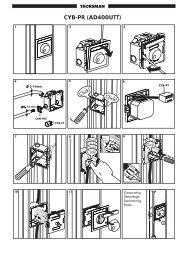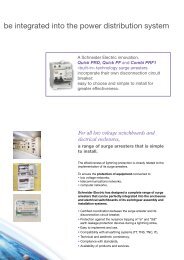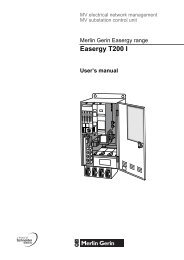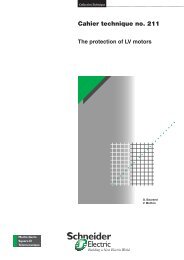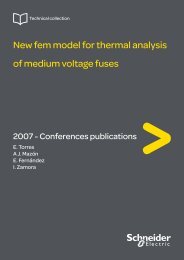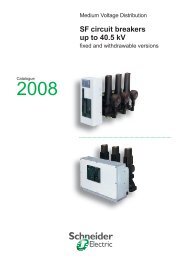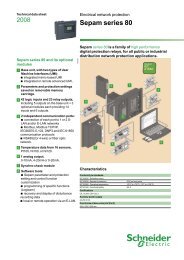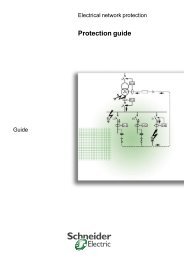Electrical ageing of composites: an industrial ... - Schneider Electric
Electrical ageing of composites: an industrial ... - Schneider Electric
Electrical ageing of composites: an industrial ... - Schneider Electric
You also want an ePaper? Increase the reach of your titles
YUMPU automatically turns print PDFs into web optimized ePapers that Google loves.
<strong>Schneider</strong> <strong>Electric</strong> 2007 - Conferences publicationshence gain much more kinetic energy. We do not needto assume the development <strong>of</strong> a large scale electronaval<strong>an</strong>che or even strong, gas phase ionisation because1 photon per second on average is only one per 50cycles<strong>of</strong> power frequency voltage which is not very much…Clearly, if voids <strong>of</strong> less th<strong>an</strong> 40µm existed, aval<strong>an</strong>ches<strong>of</strong> up to 10 6 electrons could exist, as described above. Anumber <strong>of</strong> these electrons could give rise to lightemitting mech<strong>an</strong>isms in the gas or at least when theybombard the internal surface <strong>of</strong> the void. Depending onvoid shape, on average they might be able to gain 20eVwith the tail <strong>of</strong> the statistical distribution containingeven more energetic electrons. ALL these electronsmust give up this kinetic energy on striking the innersurfaces <strong>of</strong> the void. Under these circumst<strong>an</strong>ces onemight expect a considerable amount <strong>of</strong> emission havinga spectrum corresponding to one, or both, <strong>of</strong> the twomech<strong>an</strong>isms mentioned above.Recent experiments with porous polypropylene samplesshows that partial discharges <strong>of</strong> this type are observable.Once again, at the end <strong>of</strong> the day we come to theconclusion that even these result do not really help inpinpointing the origin <strong>of</strong> electrical <strong>ageing</strong>. We need toAN ALTERNATIVE SCENARIOAt this stage, the convergence <strong>of</strong> a number <strong>of</strong> ideas <strong>an</strong>dindications, led us to reconsider the validity <strong>of</strong> thest<strong>an</strong>dard <strong>ageing</strong> scenario described above, for our highlyfilled samples. Clearly the extremely heterogeneousnature <strong>of</strong> the structure is not taken into account, Fig 10.It also neglects the well documented presence <strong>of</strong> largequ<strong>an</strong>tities <strong>of</strong> absorbed water, (0.1 – 5% weight).The results <strong>of</strong> dielectric spectroscopy on filled <strong>an</strong>dunfilled samples which have absorbed <strong>an</strong> identicalamount <strong>of</strong> H 2 O relative to the resin part, show thevalidity <strong>of</strong> such concerns. These results point to a multiparametermaxwell-wagner type interfacial polarisationmech<strong>an</strong>ism, Fig.8. Other data lead us to consider thepossibility <strong>of</strong> <strong>an</strong> inter-grain mech<strong>an</strong>ism <strong>of</strong> carriertr<strong>an</strong>sport <strong>an</strong>d interface accumulation, Fig10.One <strong>of</strong> the best known influences <strong>of</strong> water in<strong>composites</strong> is plastification <strong>an</strong>d the correspondingreduction <strong>of</strong> the glass tr<strong>an</strong>sition <strong>an</strong>d various physicalproperties. Working with both st<strong>an</strong>dard <strong>an</strong>d n<strong>an</strong>o-filledsamples we note a reduction <strong>of</strong> Tg linked directly to thequ<strong>an</strong>tity <strong>of</strong> water “in the resin part”. This reductionreaches 20°C for saturated samples, (corresponding to aTg reduction <strong>of</strong> about 30% for our samples, tg = 65°C),Fig.9.Furthermore, the principal mech<strong>an</strong>ism considered to beresponsible for the mech<strong>an</strong>ical failure <strong>of</strong> “joined”materials is the action <strong>of</strong> water at the interfaces, [5].Consequently, our latest results, which indicate thegrowth <strong>of</strong> water layers <strong>of</strong> about 2nm around each <strong>of</strong>filler grain, are <strong>of</strong> particular signific<strong>an</strong>ce [6] [7].Accordingly we are now concentrating our efforts intesting <strong>an</strong> “Alternative Ageing Scenario”.This scenario is specific to highly filled materials <strong>an</strong>d isbased on the progressive degradation <strong>of</strong> the filler/matrixinterfaces by water molecules.Fig.8: Dielectric parameters with absorbed H 2 Oknow exactly the physical mech<strong>an</strong>ism behind thephoton production, before we c<strong>an</strong> decide if it has<strong>an</strong>ything to do with electrical <strong>ageing</strong>. To confirm thesethoughts, we have initiated a series <strong>of</strong> experiments onphoton counting using artificial voids in the 10 – 100µmr<strong>an</strong>ge.Fig.9: Glass tr<strong>an</strong>sition versus atmospheric H 2 O contentN9 =9% n<strong>an</strong>o-filler, LD41=59% micro-fillerOur basic hypothesis is that a small fraction <strong>of</strong> the waterwhich diffuses into our <strong>composites</strong>, reaches thepolymer/filler interfaces where it accumulates. The405



